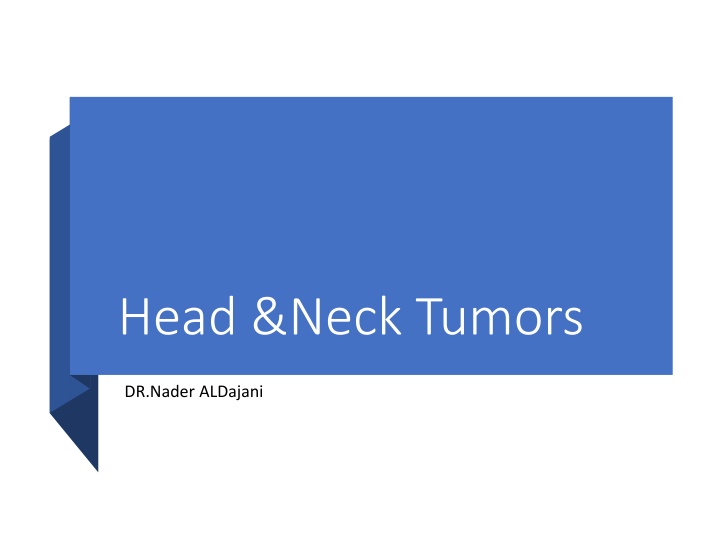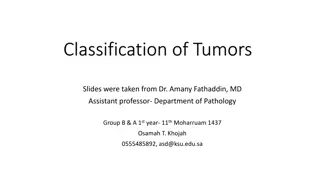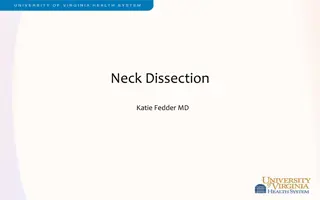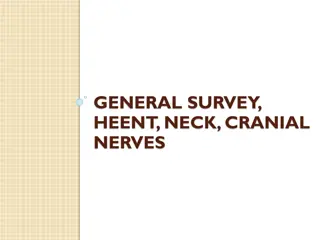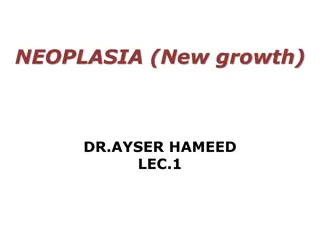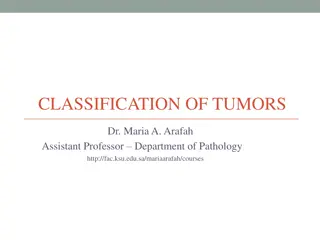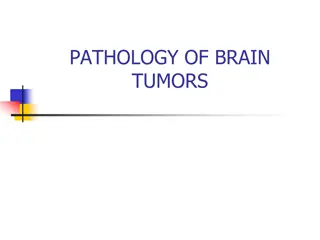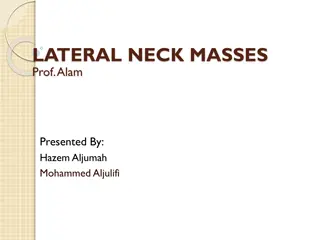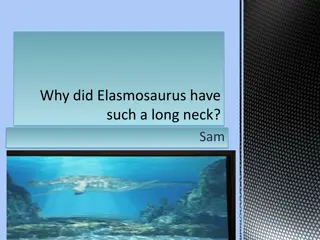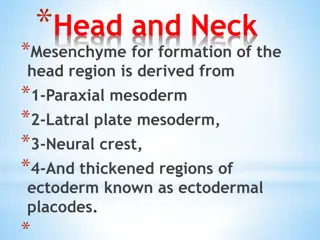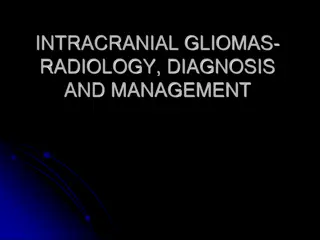Head and Neck Tumors
Different types of head and neck tumors, including oral cavity tumors, pharynx tumors, and nasopharyngeal angiofibroma. Learn about risk factors, symptoms, behavior, investigation methods, and treatment options.
Download Presentation

Please find below an Image/Link to download the presentation.
The content on the website is provided AS IS for your information and personal use only. It may not be sold, licensed, or shared on other websites without obtaining consent from the author.If you encounter any issues during the download, it is possible that the publisher has removed the file from their server.
You are allowed to download the files provided on this website for personal or commercial use, subject to the condition that they are used lawfully. All files are the property of their respective owners.
The content on the website is provided AS IS for your information and personal use only. It may not be sold, licensed, or shared on other websites without obtaining consent from the author.
E N D
Presentation Transcript
Head &Neck Tumors DR.Nader ALDajani
Oral Cavity tumor Oral Cavity tumor
Oral Cavity tumor Oral Cavity tumor Premalignant Lesions Leukoplakia, Hyperkeratosis, dysplasia and Erythroplasia Erythroplasia Greater risk of malignancy Malignant transformation greater in smokers Treatment :Surgical or laser excision 95% are squamous cell carcinoma
Risk factors Smoking (depends on dosage and type) Alcohol Tobacco chewing HPV (subtype 16) mechanical irritation (dentures)
I I- -NASOPHARYNX NASOPHARYNX
A-BENIGN Nasopharyngeal Angiofibroma Pathology: A very vascular fibroma arising from the periosteum of the roof of nasopharynx. It has tendency to bleed because there is no muscle coating its vessels. It occurs in young males below the age of 18 years. Occurs only in males in adolescent age.
Behavior And Spread: Forward nasal cavity Laterally Pterygopalatine fossa Forward and laterally orbit through inferior orbital fissure Upward cranial cavity Downwards Oropharynx
Symptoms: Signs: 1- A smooth, lobulated, firm, easily bleeding mass. a. Is seen in the nose. b. Depresses the palate and appears behind it. 1-Nasal: a. Nasal obstruction. b. Recurrent severe epistaxis. 2-Aural: Conductive deafness due to Eustachian obstruction. 2- Extension causes: a. Widening of the nasal bones b. Proptosis and frog-face deformity. c. Swelling of the cheek and zygoma.
investigation CT and MRI Carotid angiography and MR angiography shows feeding vessel of the tumor and allow preoperative embolization of the tumor to minimize intraoperative bleeding Biopsy not recommended except in operative room with facilities to control bleeding
CT of Nasophary ngeal Angiofibro ma
Treatment: Treatment: Pre-operative embolization to decrease operative bleeding . Surgical removal through combined Moure s lateral rhinotomy and trans palatal approach.
B. MALIGNANT B. MALIGNANT Squamous cell carcinoma, lymphoepithelioma and sarcoma (rare) Usually in elderly males. Common in East country.
Symptoms: Signs: Mass or ulcer seen by posterior rhinoscopy. 1. Neck mass 2. Serous otitis media 1-Nose: a. Obstruction. b. Nasal discharge. c. Epistaxis. 2- Ear: Trotter s triad: a. Conductive hearing loss. b. Earache. c. Palatal paralysis.
Investigation: 1-CTand MRI 2-Biobsy confirms diagnosis 3-Metastatic work up chest x ray brain CT bone scan and abdominal ultrasound. Treatment: radiation
II II- -Oropharynx Oropharynx
BENIGN TUMOURS Papilloma: usually asymptomatic treatment :surgical excision Haemangioma: may be capillary or cavernous. Treatment is diathermy coagulation or injection of sclerosing agents. Cryotherapy and laser coagulation is also effective
Pleomorphic adenoma: mostly seen submucosally on the hard or soft palate. It is potentially malignant and should be excised totally Mucous cyst: usually seen in vallecula. Surgical excision is the treatment of choice in case of symptomatic cysts Lipoma
Common sites of malignancy in oropharynx are: Base of tongue Tonsil and tonsillar fossa Faucial palatine arch (soft palate and anterior pillar) Posterior pharyngeal wall Gross appearance: Superficially spreading Exophytic Ulcerative Infiltrative MALIGNANT MALIGNANT TUMOURS TUMOURS
Histological classification: Squamous cell carcinoma: may be well/moderately/poorly differentiated Lymphoepithelioma Adenocarcinoma Lymphomas: both Hodgkin and non- Hodgkin
TNM CLASSIFICATION Primary tumor (T) T0 No evidence of primary tumor Tis Carcinoma in situ T1 Tumor 2 cm in greatest dimension T2 greatest dimension Tumor >2 cm but not more than 4cm in T3 extension to lingual surface of the epiglottis Tumor >4 cm in greatest dimension or T4a Tumor invades the larynx, deep/extrinsic muscle of the tongue, medial pterygoid, hard palate, or mandible Moderately advanced, local disease T4b Tumor invades lateral pterygoid muscle, pterygoid plates, lateral nasopharynx, or skull base or encases the carotid artery Very advanced, local disease
Regional lymph nodes (N) N0 No regional lymph node metastasis N1 dimension N2 6cm in greatest dimension; or in multiple ipsilateral lymph nodes, none >6cm in greatest dimension; or in bilateral or contralateral lymph nodes, none >6cm in greatest dimension N2a Metastasis in a single ipsilateral lymph node >3 cm but not more than 6cm in greatest dimension N2b Metastasis in multiple ipsilateral lymph nodes, none >6cm in greatest dimension N2c Metastasis in bilateral or contralateral lymph nodes, none >6 cm in greatest dimension N3 Metastasis in a lymph node >6cm in greatest dimension Metastasis in a single ipsilateral lymph node 3 cm in greatest Metastasis in a single ipsilateral lymph node >3 cm but not more than
Distant metastasis (M) M0 No distant metastasis M1 Distant metastasis Histologic grade (G) GX G1 G2 G3 G4 Grade cannot be assessed Well differentiated Moderately differentiated Poorly differentiated Undifferentiated
Depends upon the site and extent of the disease, patients general condition, experience of treating surgeon and facilities available. TREATMENT TREATMENT Options of treatment are: Surgery alone Radiation alone Surgery+radiotherapy Chemotherapy+surgery+radiotherapy Palliative therapy
Team approach: surgeons and Radiation Oncologists SLP Treatment Treatment T1 and T2 surgery or radiation T3 and T4 combined modality
III III- -Hypopharynx Hypopharynx
1- Post-Cricoid Carcinoma It is more prevalent in females over 40 years old Symptoms: 1. Progressive dysphagia. 1st to solid then to fluids. 2. Hoarsness of voice and stridor due to invasion of larynx or recurrent laryngeal nerve. 3. Neck mass due to nodal metastasis. 4. Referred pain. 5. Loss of weight.
Signs: 1. Moure s sign i.e. absence of laryngeal click. 2. Cervical lymph node usually enlarged unilateral hard fixed to deep structures 3. By indirect laryngoscopy, or rigid endoscope the tumour is seen behind the arytenoids covered with froth. May be affection of vocal cord mobility.
Investigations: 1. Lateral X-ray shows widening of the tracheo-vertebral space 2. Barium swallow shows filling defect or obstruction 3. CT and MRI show extension, invasion and LN involvement. 4. Biopsy by hypopharyngoscopy. 5. Metastatic work up plain xray chest,CT brain and abdominal ultrasound. Treatment: - Layngo-pharyngectomy and block dissection. Phx. is reconstructed by Myocutaneous flap,Colon
or Jujenuminterposition or Stomach pull up. - Irradiation
2-Cancer Pyriform Fossa More common in elderly males 6th 7th decade of life. Symptoms: Early vague throat discomfort or neck lump Later - Progressive dysphagia to solids than to fluids (less than in PCC). - Hoarseness of voice due to laryngeal invasion. - Referred otalgia.
Signs: 1. Enlarged, hard cervical glands may be the earliest sign. 2. A pool of mucus in the pyriform fossa covering a mass or ulcer is seen by indirect laryngoscopy. Investigation: Same as Post Cricoid carcinoma. Treatment: Laryngo-pharyngectomy (Glue s operation) and block dissection. Irradiation before and after the operation.
Hypopharynx: Primary tumor (T) T0 No evidence of primary tumor Tis Carcinoma in situ T1 dimension Tumor limited to 1 subsite of the hypopharynx and/or 2cm in greatest T2 site or measures >2 cm but not more than 4 cm in greatest dimension, without fixation of the hemilarynx Tumor invades more than 1 subsite of the hypopharynx or an adjacent T3 extension to the esophagus Tumor >4 cm in greatest dimension or with fixation of the hemilarynx or T4a Tumor invades thyroid/cricoid cartilage, hyoid bone, or central compartment soft tissue (including prelaryngeal strap muscles and subcutaneous fat) Moderately advanced, local disease T4b Tumor invades prevertebral fascia, encases carotid artery, or involves mediastinal structures Very advanced, local disease
A.Benign 1-Epithelial: Papilloma. 2-Connective Tissue: Fibroma and angioma. Squamous cell papilloma It is single in adults and multiple in children.
In adults In children Single and true neoplasm. Multiple, viral or hormonal. Causes hoarseness, rarely obstruction. Causes stridor and hoarseness. Exclusively cordal in anterior 1/2. Multiple, affecting any part of the larynx. Removal by direct laryngoscopy and if big,through laryngofissure Repeated removal by direct laryngoscopy,microsurgery and cryosurgery No tracheostomy. Tracheostomy, close it after removal each time (larynx grows normal) No recurrence. Recurs rapidly till puberty. May turn malignant. Does not -turn malignant.
B.Malignant Tumours Usually squamous cell carcinoma. Predisposing Factors: 1. Leucoplakia. 2. Papilloma in adults. Age: Over 40. Sex: Males are more affected than females by 10: 1. Types: 1. Glottic (on the cords) 70%. 2. Supraglottic 20%. 3. Subglottic 10%.
Symptoms: 1. Hoarseness appears early in cordal carcinoma, late in other types. 2. Dyspnoea and stridor early in subglottic carcinoma 3. Discomfort in the throat early in supraglottic carcinoma 4. Late pain due to invasion and perichondritis 5. Dysphagia indicates infiltration of pharynx 6. Haemoptysis. Weight loss and neck swelling as late symptoms 7. Referred pain to the ear.
Sign: 1-laryngeal examination may shoes a) Bilateral fungating mass in supraglottic tumors. b) Unilateral thickening or roughness of vocal cords later on cauliflower mass in glottic tumor. c) Bilateral ulcerofungating mass in subglottic tumor. d) Fixation of vocal cords and tenderness of larynx due to perichondritis or its invasion. 2-Enlarged cervical glands and broadening of larynx
supraglottic carcinoma glottic carcinoma subglottic carcinoma
Investigations: 1-CT or MRI evaluate a- Tumor limits b- Cartilage invasion c- extralaryngeal spread d- LN involvement 2-Direct Laryngoscopy under general anesthesia to map tumor and get biopsy 3-laboratory a) Test to exclude syphilis and sputum to exclude TB b) C.B.C, renal and liver functions as preoperative investigations
Classification and Staging: Primary Tumor: T1 Tumor limited to one site with normal vocal cord mobility. T2 Tumor extending to more than one site with normal vocal cord mobility. T3 Tumor limited to larynx with vocal cord fixation. T4 Tumor extending beyond the larynx. Lymph nodes (N): N0 No clinically positive nodes. N1 Single clinically positive ipsilateral node 3 cm or less in diameter. N2 Single clinically posi? ve node more than 3 cm but less than 6 cm in diameter. N3 Massive ipsilateral nodes (>6cm), bilateral or contralateral nodes.
Distant metastasis (M): M0 No evidence of distant metastasis. M1 Tumour with distant metastasis. Treatment: 1- Limited excision with a safety margin through laryngofissure. (In T1 and T2) 2-Total laryngectomy: T3 and T4 If the cords fixed or if there is extension outside the cord to: I. Anteror commissure II. Atytenoids III. Subglottic IV. Supraglottic
3- Total excision and block dissection of the cervical lymph glands: If the cervical lymph glands are palpable. 4- Radiotherapy (5500 rads):T1 and T2 In early cordal cancer and in late cases. 5- Inoperable Cases: Extensive infiltration or distant metastasis. a. Radiotherapy. b. Cytotoxic drugs. c. Sedatives as morphine. d. Tracheostomy when indicated. e. Gastrostomy for dysphagia.
